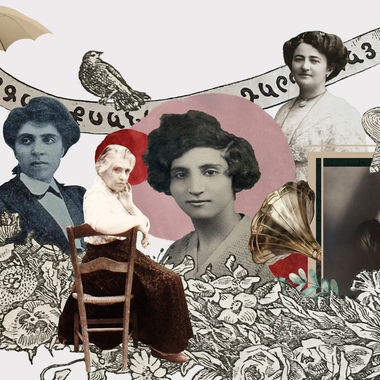Sun Jun 06 2021 · 10 min read
From the Forgotten Pages of History: Zabelle Boyajian, an Ambassador of Armenian Culture

By Arpine Haroyan
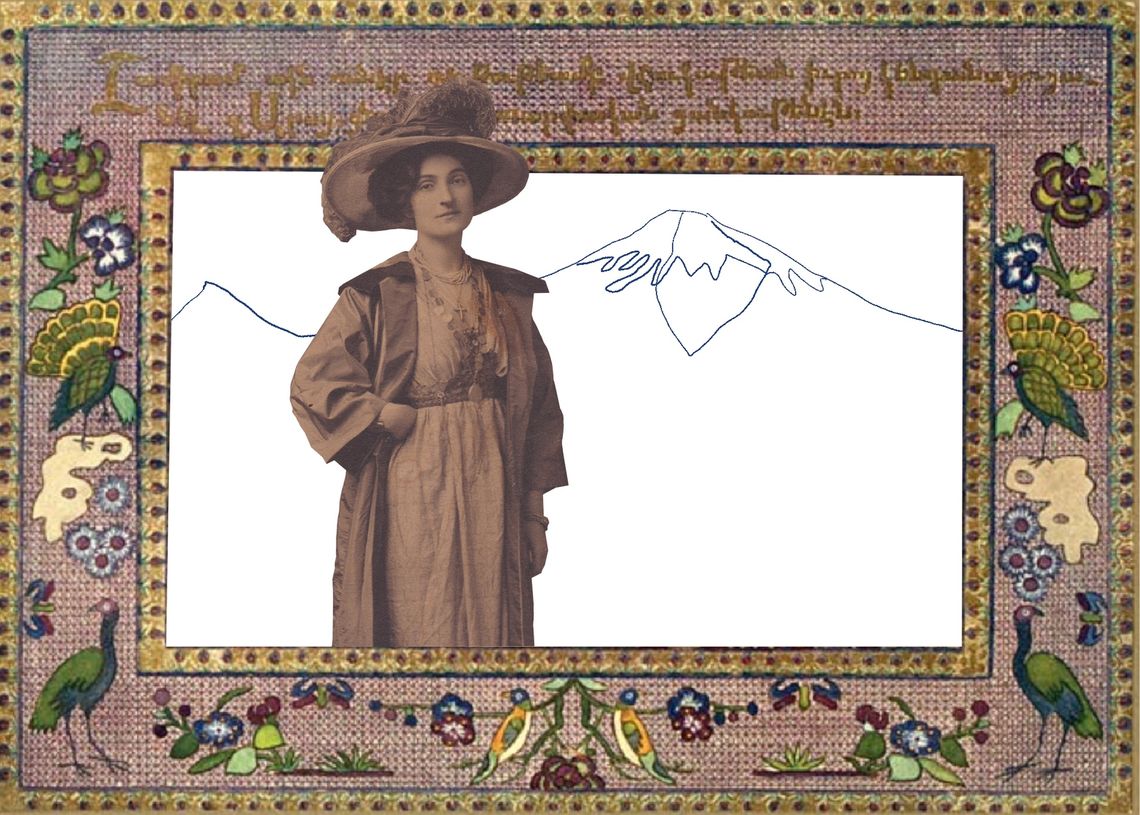
Illustration by Armine Shahbazyan.
Zabelle Catherine Boyajian (1872-1957) was an artist, writer, translator and activist and one of the most successful and well known British-Armenian intellectuals of her time. A woman famous for her articles on Armenian literature in British magazines, the first “eastern woman” artist to be exhibited in Europe, an author of books and numerous paintings.
Zabelle Catherine was born in 1872 (according to other sources, she was born in 1873) in Diyarbekir into the family of Thomas and Catherine Boyajian. Her father, Thomas Boyajian, was a graduate of the prominent Protestant Bebek Seminary in Constantinople and was a very well known public figure in Diyarbekir. In the mid-1880s, he served as British Vice-Consul in the Ottoman Empire and, prior to that, he was head of the Protestant church in Diyarbekir. During one of his many travels to England, it is believed that Boyajian delivered a sermon before Queen Victoria.[1]
Zabelle’s mother, Catherine Rogers, was British and a descendant of the famous English poet Samuel Rogers. She met Thomas in London. After their marriage, the couple moved to the Ottoman Empire.
Growing up in Diyarbekir, Zabelle and her younger brother Henry were homeschooled on various subjects and languages.
“...She had lessons on all subjects for us every morning: by the time I was about fifteen or sixteen, I had read and loved Shakespeare’s plays, Spencer, Milton, Chaucer and many other poets, and knew half of them by heart…”
Zabelle had a blissful childhood. As she recalled in her memoirs, they used to spend summers in their country house in Kharpert, where she would enjoy the beauty of her homeland and family gatherings. However, the peaceful phase of her life ended in the beginning of the 1890s, when Ottoman authorities began to ethnically cleanse Armenians from their ancestral land.
When the Sasun massacres began in 1894, Thomas Boyajian, who actively voiced the struggles of Armenians in Diyarbekir, immediately informed his British and European colleagues about the situation and described the atrocities committed by Turkish officials. But a year later, Thomas died and Diyarbekir was no longer a safe place to stay.
Terrified by the unfolding events, Zabelle’s mother decided to move to London with her children. As a British subject, she also managed to take several friends with her, saying that they were their servants. The family’s journey to Constantinople from where they were to travel to England lasted several weeks. During this time, young Zabelle witnessed horrific scenes of massacres and the struggles of Armenians.
“I survived the massacres of 1895, having barely escaped with my life. I shall never forget the wretchedness and hopelessness of the Armenians that we saw in every town and village on our 15 days’ journey to the sea-coast,” she later wrote in the November 1914 issue of the English-language Ararat magazine.
After reaching Constantinople, the Boyajians decided to change their plans and went to Cyprus first and later to England. During their stay in Nicosia, Zabelle and her mother joined a newly-built workshop for the survivors of the Hamidian massacres, and took care of orphans and widows. Toward the end of 1896, the Boyajians finally managed to move to London. Zabelle, who had a passion for the arts, entered the Slade School of Fine Art at the age of 24. Although the family, barely escaping the massacres, was now safe in London, their thoughts were constantly with the Armenians struggling under the rule of the Ottoman Empire.
Zabelle’s biographer Trdat Khorshidyan writes in his book “Zabelle Boyajian’s Life and Activities,” that Zabelle’s mother, who was very attached to Armenian culture and people, started to address letters to local magazines after settling in London, calling on the British government to take action and help the Armenians. Toward the end of the 1890s, the Boyajians became acquainted with the London Union of Armenian Workers and Students and Zabelle fully immersed herself into the active life of the Armenian community.
The organization uniting Armenians throughout London had been founded in 1898 by Anna Raffi (the wife of the well-known Armenian writer Raffi) and her two sons, Aram and Arshak, who had moved to England in the 1880s. The London Union of Armenian Workers and Students organized various events presenting and promoting Armenian culture and tried to raise awareness about the condition of the Armenian people living in the Ottoman Empire. Zabelle soon became close friends with Raffi’s family and together dedicated herself to promoting Armenian culture.
In 1901, Zabelle published her first English-language novel entitled “Yestere: the Romance of Life,'' which aimed to raise awareness among the British about the horrific situation of the Armenians and was inspired by the events Zabelle witnessed during her long journey from Diyarbakir to Constantinople.
Using the pen name Varteni in order to protect her relatives in Constantinople, the book was a revelation and shock for the British public, many of whom were hearing about the Armenians for the first time.
Years later, the novel was translated into German and published in Germany. According to Khorshidyan, the book was also translated into Armenian but was never published in that language.
Even though Zabelle garnered attention for her novel, her true passion was painting. Years after graduating from the Slade School of Art, she held her first exhibition in one of London’s galleries and, according to British Madame magazine, became the first ever “eastern woman” to be exhibited in Europe. The successful exhibition was followed by another one in France, bringing fame to Zabelle across Europe and within the Armenian community during the 1910s.
Besides painting, Zabelle also committed herself to translation. During the first decades of the 20th century, she actively translated Armenian literature and presented it to the British public. Moreover, she also contributed to British periodical Contemporary Review as well as Armenian periodicals Hayastani Kochnak in Boston, Gegharvest in Tbilisi and English-language Ararat magazine in London, for which she specifically translated some chapters from Raffi’s famous novel “Samvel.”
In 1916, after years of hard work and research, Zabelle published her groundbreaking book, “The Armenian Legends and Poems” and adorned it with illustrations. The book, which today is considered to be one of the few in-depth representations of ancient Armenian tales and legends, was co-authored with Aram Raffi. Proceeds from the sale of the book were handed over to the Armenian Fund in London, which aimed at helping Armenian refugees.
“The Armenian Legends and Poems” featured an introduction by renowned British academic, historian and politician James Bryce, who was one of the few people voicing the struggles of Armenians, a long essay by Aram Raffi entitled “Armenia: It’s Epics and Medieval Poetry,” and translations of poems of Armenian writers, poets and historians from different time periods. Those included Armenian medieval poet Nahapet Kuchak, poet and musician Sayat Nova, 5th century historian Movses Khorenatsi, writers Avetik Isahakyan, Arshag Chobanian and others. Zabelle also included contemporary women authors such as Shushanik Kurghinian, Zabel Yesayan and Italian-Armenian Vittoria Aganoor.
The illustrations of the book drawn by Zabelle were inspired by Armenian manuscripts and miniatures and depicted various scenes from Armenian legends, accompanied with short descriptions. The illustrated legends included “Founding of Van,” “The Wedding,” “Ara and Semiramis (Shamiram),” “Artashes and Satenik,” “Christ’s Letter to Abgarus,” “The Legend of Akhtamar,” “The Lady and the Minstrel,” “Armenia,” “The Castle of Anoush,” “The Birth of Vahagn, King of Armenia,” “Artavasd” and “The Vision of Rosiphelee, Princess of Armenia.”
The book immediately gained the attention of British society and was praised in local and Armenian media. British magazine Contemporary Review wrote that the Armenian Legends and Poems is a “...noble garland of Armenian flowers, and gallery of pictures that Miss Boyajian has given us—pictures in which the pre-Raphaelite note is splendidly dominant; pre-Raphaelite, that is to say, Byzantine or Armenian art revived.”
Zabelle wrote in the preface that her goal was to publish the book “as a memorial to an unhappy nation” and also indicated that she might prepare and publish a second volume. However, that never happened. In a profile about Zabelle Boyajian, published in AGBU’s quarterly Ararat magazine in 1960, A. Bedikian noted that Zabelle’s “own estimation of the book” was not particularly high. According to him, Zabelle thought that her creative genius was not recognized properly and the book was praised because of its Armenianness. Until her last years, she refused to publish another edition of the book and complained that she had other works to be published as well.
After the publication of the book, well-known Shakespearean scholar Sir Israel Gollancz asked Zabelle to write a special poem dedicated to Shakespeare’s 300th birthday to be included in a book entitled “Homage to Shakespeare.” She immediately accepted and wrote a short poem “Armenia’s Love to Shakespeare'' which to Zabelle’s great surprise was read during the book launch along with English novelist and poet Thomas Hardy’s poem. According to Bedikian, Zabelle took great pride in that particular poem and was proud that she could represent Armenia in a book commemorating Shakespeare.
“I was asked to write for the big Book of Homage to Shakespeare to which a great many of the best writers in England had contributed. And also writers from almost every country. At the national celebration, with all the Foreign Ambassadors, and members of the Government on the platform in the Hall, two poems were read out of the Book - one by Thomas Hardy, then the Poet Laureate, and the other mine,” Zabelle wrote in a letter to Bedikian.
Following her successful poem in “Homage to Shakespeare,” Zabelle illustrated the Armenian translation of “Hamlet” for the Mekhitarists’ publication in 1921.
During the 1920s, Zabelle actively travelled across Europe and was mainly engaged in painting landscapes. According to Khorshidyan, she had solo and group exhibitions in the Fine Art Gallery on Bond Street in London, participated in the National Portrait Society and held exhibitions in Germany.
While touring Italy in 1923, she wrote an article series for “Hayastani Kochnak” magazine entitled “The Charm of Italy,” through which she shared her thoughts and impressions of the Italian people and beautiful landscapes. Zabelle also spent several weeks in Venice and researched the archives of the Mekhitarist Congregation on Saint Lazarus Island. During that time, Zabelle met Armenian writer Avetik Isahakyan and became close friends with him. Years later, she translated his poem “Abu Lala Mahari” into English and published it in the American-Armenian media.
In 1924, Zabelle published “Gilgamesh: A Dream of the Eternal Quest,” which presented her version of the famous Akkadian epic and included her illustrations. In letters to Arshag Chobanian and Avetik Isahakyan, Zabelle mentioned how excited she was about the publication and how much she wanted Armenians to know her work.
In 1928, she visited Egypt and had a solo exhibition in Cairo. An article in the English language Egyptian Sphinx magazine entitled “An Artist and a Poet” described Zabelle as a portrait painter and praised her as an accomplished writer.
Throughout her life, Zabelle earned a living by selling portraits and by contributing to British and Armenian periodicals. She got inspiration from visiting various places across Europe and later incorporated that in her art. In 1938, after her long travels across Greece and the Greek Islands, she published a catalogue of paintings and travel notes entitled “In Greece with Pen and Palette.”
Zabelle Boyajian never married and did not have children. During the Second World War, she stayed in London and continued painting and writing. With the assistance of the Armenian Church in the United States, she published a play entitled “Etchmiadzin” which she hoped would be staged in Armenia. However, the play was only staged once in New York.
During her later years, Zabelle found happiness in constant correspondence with her friends across the world and expressed her desire to travel to Armenia. She died in 1957, at the age of 84, in a London hospital, leaving behind a legacy that included paintings, unpublished writings and memoirs.
Unfortunately, many details about Zabelle’s life are unknown to us since there is scarce information about her. Even though most of her activities are known to the public, her character still remains a mystery to many. In one of her letters, she mentioned that she was a member of Club Alpin Francais. She notes that she is against feminism and that she is a pacifist. Zabelle also knew six languages. However, she still needs to be discovered…
Today, 17 of Zabelle’s letters are kept at the Yeghishe Charents Museum of Literature and Arts and her archive is kept at the Zoryan Institute. According to various sources, her paintings are spread across the world and are kept in private collections and galleries. Her portrait of Raffi is kept at the Yeghishe Charents Museum of Literature and Arts, and one of her paintings is at the National Gallery of Armenia.
As Bedikian later wrote, “Z. Boyajian did the same for Englishmen and English-speaking people as Chobanian did for Frenchmen and French-speaking people. They both became the great translators of Armenian life, thought, culture and art into the two European centers – Paris and London.”
Special thanks to the staff at the Yeghishe Charents Museum of Literature and Arts.
------------------------
[1] “Amitai Ardzaganknery,” Tigran Mkund, New Jersey, 1950, p. 325-326.
References
“Amitai Ardzaganknery,” Tigran Mkund, New Jersey, 1950.
“Zabelle Boyajian,” Trdat Khorshidyan, Yerevan, 1990.
“Armenian Legends and Poems,” Zabelle Boyajian, London, 1916.
“Zabelle Boyajian: Letters,” in Haigazian Armenological Review, edited by Melania Yeghiazaryan, Beirut, 2010.
"The Poet and Artist: A Profile of Zabelle Boyajian," A. A. Bedikian, Ararat Magazine Vol. 1, No. 3, Summer 1960.
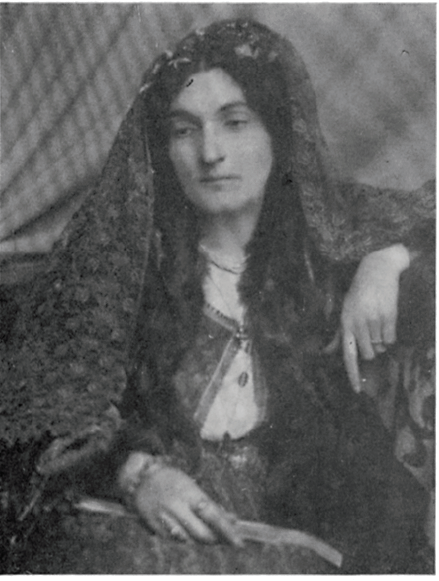
Zabelle, 1910s, London.
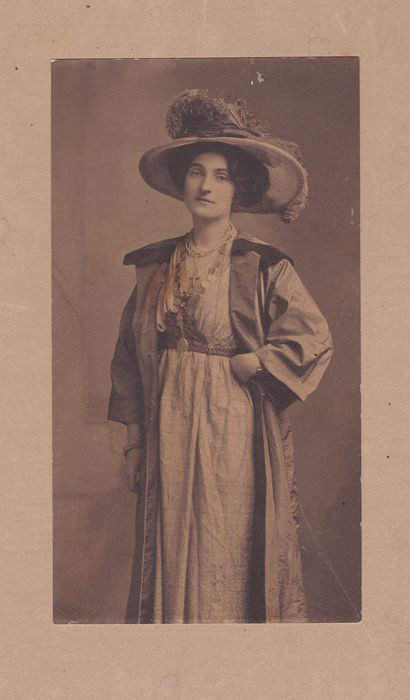
Zabelle, 1913, London.
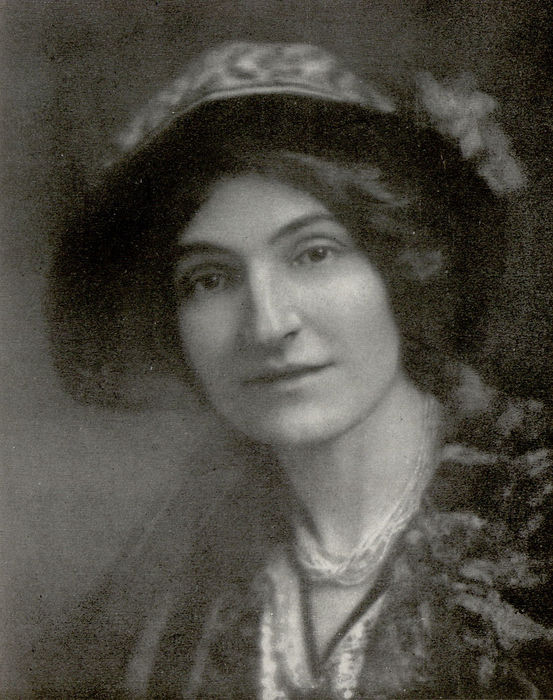
Zabelle, 1910s, London.
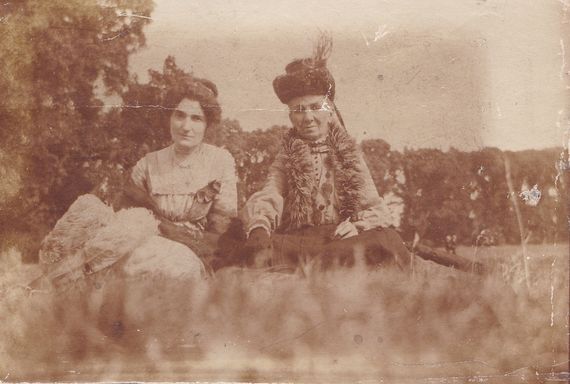
Zabelle with Anna Raffi, 1910s, England.
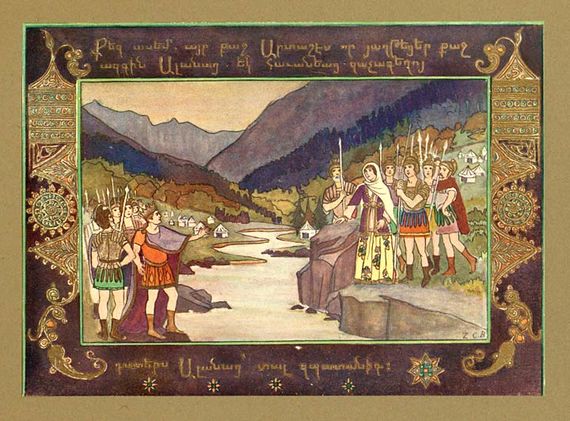
“Artashes and Satenik,” an illustration from the “Armenian Legends and Poems,” 1916.
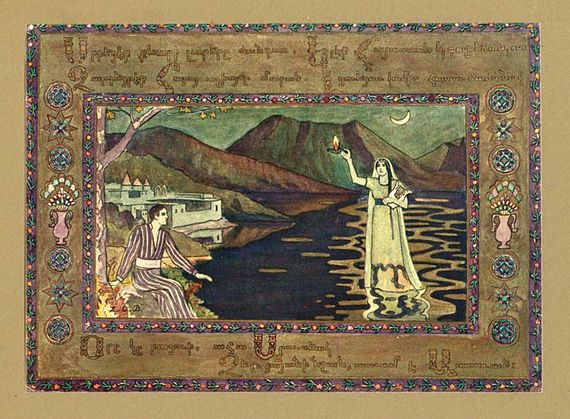
“The Lake of Van,” an illustration from the “Armenian Legends and Poems,” 1916.
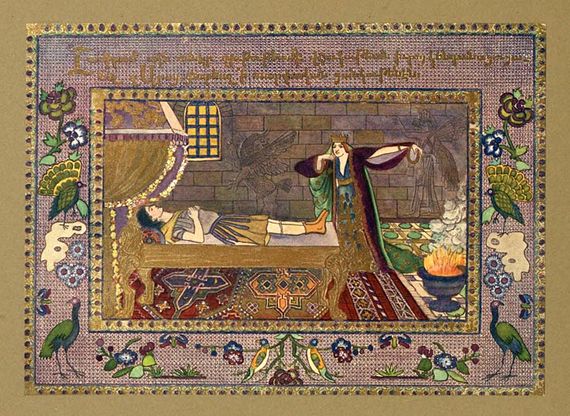
“Ara and Semiramis,” an illustration from the “Armenian Legends and Poems,” 1916.
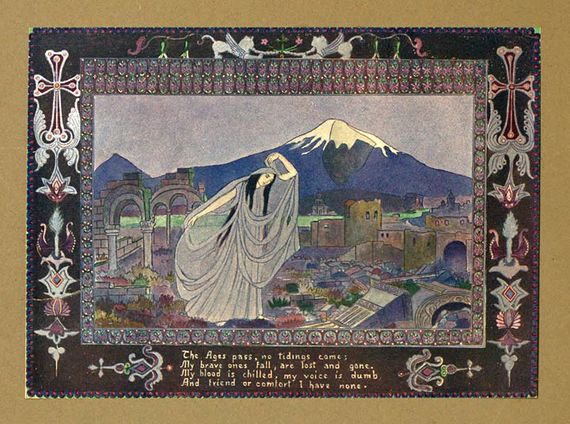
“Armenia,” an illustration from the “Armenian Legends and Poems,” 1916.
From the Frogotten Pages of History
From the Forgotten Pages of History
The Forgotten Pages of History is a special series of articles, EVN Report's tribute to Armenian women who have been left out of the collective memory of the nation, women whose work and devotion to ideals and whose biographies can inspire generations if only they are remembered.

